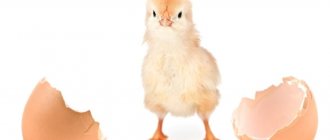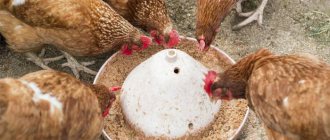How is the egg direction characterized?
Before talking about the amount of egg production per month that can be obtained from one chicken, it is worth understanding in more detail the characteristic features of these birds.
First of all, this includes precocity. In laying hens, puberty occurs early, and the first eggs are received from the 6th month of life.
Silver brekel
Egg-laying chickens have a small weight, which on average reaches about 1.5 kg. The bird is also highly physically active. Masonry requires not only proper diet, but also constant movement. If you pay attention to an egg-laying hen, you will see that the bird is actively moving all day.
Calcium consumption increases. The bird cannot obtain the necessary microelement on its own, which means it will have to use special supplements so that the balance is not disturbed.
There is no maternal instinct. During hatching, most hybrids almost completely lost the ability to hatch chickens; their main task is to lay eggs in large quantities.
To briefly summarize the above, egg crosses have only one positive feature - laying eggs.
When the pullets start laying eggs
In poultry farming, according to egg productivity, there are three main directions: egg, meat-egg and meat.
Dwarf and fighting chickens are bred for decorative and entertainment purposes. Some representatives of these breeds lay few testicles. It is better to use them in breeding offspring, and not to sell them as food.
The period of egg production in birds of each line begins at different times.
Chickens of egg-laying varieties begin to produce eggs at the age of 4.5 months.
Individuals of meat-egg lines are introduced 1-1.5 months later.
Heavy, meaty types of chickens gain weight first and then take care of the chicks. Their egg production begins at 7-8 months.
Find out all the details in the article “At what age do chickens start laying eggs.”
A few words about performance
It is worth noting that no one has made exact calculations; there are only approximate parameters for each breed. But even here there is a very serious discrepancy in the numbers. The fact is that there are a huge number of factors that affect poultry performance. This should include such important indicators as:
- keeping chickens;
- seasonality;
- presence of stressful situations.
On average, in 30 days, one chicken can lay about 29 eggs, and in some cases even less. What is the reason for such indicators?
Here it is worth turning to biology. An egg is a large egg cell, which is located in an albumen shell and is covered with a shell for preservation. After the yolk ripens and enters the oviduct, the protein component begins to grow, moving the future egg forward and forming a shell. Nature has allocated a little more than 24 hours for this process, and a way to speed up this process has not yet been found. But when unfavorable conditions appear, the process slows down perfectly.
Monthly and annual productivity
Determining how many eggs a laying hen lays per month is not difficult, knowing how many it produces per day or week. The daily norm must be multiplied by the number of days of the month being calculated, and the weekly norm by 4. The result is the average egg production per month. Usually this figure is no less than 15, but rarely exceeds 30.
One of the factors, in addition to content, is the breed of chickens, because representatives of different varieties do not lay the same amount.
To calculate how many eggs a chicken lays per year, it is necessary to calculate the quarterly egg production for each period. The resulting amount usually starts at 200 and ends somewhere around 350 pieces. These figures are based on statistics, which means there are exceptions. There are cases when a chicken was able to produce more than 370 pieces in 1 year. The indicated approximate figures are a basis from which you can build, but do not despair if there are any deviations.
What does egg production depend on?
First of all, you need to choose the right breed. A record number of eggs - more than 370 - can only be obtained in research farms. Even the most experienced breeders do not receive more than 350 eggs from their pets; on average, this figure decreases to three hundred, which is simply an excellent result.
In the following table you can see the different breeds and egg production rates.
| Breed name | Number of eggs in 365 days | Average weight of laying hens, kg | Weight of egg products, g |
| Russian white chickens | 200-240 | 3,3 | 56-60 |
| Leghorn | 200 -240 | 2,1 | 55-60 |
| New Hampshire | 180-240 | 3,0 | 50-70 |
| Loman Browns | 314-321 | 2,1 | 64 |
| Brekeli | 180-200 | 2,3 | 60 |
| Russian Crested | 160-180 | 1,9 | 55-60 |
| High line | 340-350 | 1,7 | 60-65 |
| Hisex browns | 280-300 | 2 | 70 |
| Hisex white | 280-300 | 1,8 | 63 |
Daily and weekly productivity
Every day a chicken can lay one egg, provided that all husbandry rules are followed. In the cold season, laying hens produce fewer eggs: egg-producing hens produce one egg every two days, while other hens may not lay eggs at all in winter.
How many eggs chickens lay per week depends on the conditions and time of year. The minimum quantity is 3 eggs (every other day in winter) per week. Maximum - 7 eggs (every day in summer). These data are calculated based on the average.
Ways to Increase Productivity
Every farmer thinks about the egg production of chickens and stable productivity indicators for 365 days a year. Coping with such a task is not very easy, but it is possible if you know some subtleties.
Russian white chickens
First of all, chickens need to create conditions as close to ideal as possible and provide the flock with a properly formulated balanced diet. Most often, on a small farm, you can notice how in the summer the amount of egg production increases significantly, and with the onset of cold weather it declines. Such fluctuations are caused by a decrease in temperature, even taking into account the fact that the chickens are indoors, and some types of feed are no longer available. But at an industrial poultry farm, the jumps described above are absent due to the fact that the livestock is in approximately the same conditions all year round.
Russian Crested
How many eggs does a chicken lay per year, week, day: possible problems and ways to solve them
A conscientious farmer should study their breed characteristics before purchasing chickens. The quality of the microclimate created for the comfort of birds in the chicken coop depends on this.
Chicken capabilities
The egg production of chickens depends on many factors:
- Breed characteristics. You need to find out about them from breeders. Many breeds have certain maintenance and care features that will ensure productivity at the highest level.
- Balanced diet. When eggs are formed, the chicken's body loses a large amount of energy, which must be maintained with proper nutrition.
- Comfortable microclimate. Temperature and air humidity in the barn for birds has a direct impact on the performance of hens. Lighting also has an impact on this process.
- The quality of care stimulates the uninterrupted laying of eggs, affecting the health of laying hens.
- Plumage condition. During periods of molting, the chicken body reduces egg production and restores it after the change of plumage.
If all the conditions are met, the chicken is healthy and not in the molting stage, its average production is 1 egg per day. This figure varies from 1 to 7 pieces per week, from 15 to 30 pieces per month, from 120 to 330 pieces per year. The direction of the breed is of great importance. Possibilities of laying hens in the following areas:
- Meat. These breeds are large. They grow quickly and gain muscle mass. Raised for tasty meat. They cannot boast of egg productivity. They produce from 80 to 120 eggs per year.
- Egg. These hens are bred to produce eggs. They weigh little and are not suitable for meat. Their productivity reaches 300 pieces. in year.
- Universal breeds have high egg production and medium size. Among them there are many crosses, the productivity cycle of which is limited to 1 year. They carry up to 330 food units per year. When this indicator decreases, they are slaughtered.
Tips for poultry farmers
To obtain the maximum amount of egg production and stabilize indicators, private farm owners are advised to pay attention to the following factors:
- Feeding livestock. It is very dangerous to underfeed and overfeed egg-laying chicken breeds. The bird should receive fresh and high-quality food, rich in vitamin and mineral complexes. Today, experts have developed special additives that significantly increase the productivity of egg products. It is important to follow the instructions here.
- Maintaining temperature conditions. Chickens, and all other poultry, instantly react to such an important indicator, especially when it begins to change. If the temperature is too high or low, productivity will certainly decrease. With the onset of heat, it is necessary to ventilate the room, and in the winter months, if necessary, turn on additional heating sources.
- Lighting. As daylight hours decrease, the bird begins to lose its activity: it eats less food, reduces the number of movements - all this leads to fewer eggs being laid. To avoid this, it is necessary to maintain daylight hours between 12 and 14 hours. The first indicator is the minimum, the second is the maximum.
- Humidity indicators. It is best if the indoor humidity is kept at 60-70%.
- Number of livestock in the chicken coop. According to the standards, there should not be more than 4 birds per 1 square meter in a chicken coop. When kept in cages, this indicator will be completely different; it is important that poultry farmers comply with the developed standards. The same applies to arranging the premises with nesting houses, perches, and food containers. All this should be convenient for the chickens.
- Providing chickens with walks in winter. This is also a very important aspect that affects the amount of egg production. If weather conditions permit, the bird should be able to go out into the yard. Such a promenade will have a positive effect on the general condition of the chickens, and at the same time stimulate egg laying.
- Systematic veterinary examinations. A healthy bird lays eggs well, but if mites, feather eaters and other parasites appear that cause concern to birds, the amount of production will inevitably decrease or the process will stop altogether.
It is important to remember that laying hens' productivity decreases with age, and this does not depend on external factors.
We invite you to join our Zen channel and group on VKontakte or Odnoklassniki, where new articles are published, as well as news for gardeners and livestock breeders.
Similar articles:
- Liera among chickens for seasonal poultry farming. Which breed should I choose?
- What should a new farmer know about feeding chickens?
- Frostbite in chickens: what do you need to know about the signs and treatment?
What affects egg production?
Several factors influence the egg production of chickens:
- proper care and feeding;
- age and health;
- breed;
- season.
How does breed affect egg production?
Among the breeds of chickens, special egg breeds can be distinguished:
- Leghorn;
- Tetra TL;
- Laurent Brown;
- Hein Line;
- Ukrainian earflaps;
- Russian white.
Chickens of these breeds begin to lay eggs at 4-5 months. Their distinctive feature is their special egg production. Having laid 361 eggs in one year, the Leghorn chicken was included in the Guinness Book of Records in 1930. With proper feeding and proper care, a laying hen produces an average of 270-330 eggs per year. Laying hens differ from other breeds in their small size and weight, stable comb and dense plumage.
Most universal meat and egg breeds are born by crossing meat and egg chickens. These birds begin to lay eggs at 5-6 months. These hens are not as productive as laying hens: one hen per year can produce from 170 to 200 eggs.
Considering their weight, this can be considered a good result. Noting the taste of the eggs of these chickens, some poultry farmers say that, compared to ordinary laying hens, their taste is better.
The best laying hens among meat and egg breeds are:
- Anniversary Kuchinskie. A chicken of this breed can lay 230 eggs per year.
- New Hampshire. A young laying hen produces approximately 200 eggs per year.
- Rhode Island. The egg production capacity of this breed reaches 200 eggs per year.
Meat breeds are not entirely suitable as laying hens. Raised exclusively for meat, these chickens do not have time to reach sexual maturity, which occurs at 6-7 months.
Raising meat chicken breeds for eggs is simply not profitable, since they eat a lot. Such birds are distinguished by their large size, massiveness, sparse plumage and thick short legs.
A meat chicken produces 120-150 eggs on average per year. The eggs of meat breed chickens are larger than regular eggs.
Influence of conditions of detention
The conditions of keeping chickens directly affect egg production. Conditions on a poultry farm differ significantly from those at home. At home, keeping laying hens requires a ventilated special room separate from other animals and birds.
The chicken coop should be located in an elevated, dry place. There should be a fenced-off area nearby for the birds to walk. The temperature in the chicken coop in summer should be +23-+25°C, and in winter it should not fall below +15°C.
The floor in the chicken coop should be covered with a thick layer of straw, so that the chickens will freeze less in winter. For 5 laying hens, 1 square meter of space is required; for 20 laying hens, a chicken coop measuring 4 square meters is sufficient.
It should be equipped with perches located primarily opposite the window. In the corners of the room it is necessary to place small boxes covered with straw for nests.
For high egg production rates, birds require good lighting. For this, the chicken coop must have windows, and in winter additional lighting is required throughout the daylight hours (13-14 hours).
Depending on the number of chickens, there should be several feeders and drinkers. There should be at least one of them on the run and in the chicken coop. Do not forget about the cleanliness of the feeders and the birds themselves. To get rid of parasites, chickens can be given a mixture of sand and ash.
Laying hens should have a balanced, nutritious diet rich in vitamins and microelements. It is useful to yeast and germinate food. Birds are fed 3-4 times a day. In summer, the approximate amount of feed for one chicken is 140 grams, in winter - 120 grams.
The conditions for keeping laying hens at poultry farms are slightly different, where they usually use concrete poultry houses that do not collapse during disinfection. Chickens are kept in cage batteries with 50-75 W lamps attached above them. The poultry house must be equipped with a ventilation system.
In winter, poultry farms are always heated using boiler rooms. Special mechanized drinkers and feeders on poultry farms are adapted for feeding birds. The machines clean the premises and collect eggs.
Best breeds
The breeds that achieve high egg production are mainly crosses.
Cross is a breed created by crossing several representatives of the breeds. Such chickens cannot be bred at home without losing the desired characteristics. Their disadvantage is a short productivity cycle. Upon reaching 2 years of age, they sharply reduce productivity and are only suitable for meat.
Popular breeds with large egg output:
- Leghorns are large chickens. Their rate reaches 230 eggs per year. They are not crosses, which allows them to lay a large number of eggs for 3-4 years. They do not reduce their production rates with age.
- Loman Brown is a cross breed. In the first year it carries up to 330 food units. This makes it one of the most productive.
- Hisex Brown can carry up to 350 pieces. in year. The weight of 1 testicle is 65 g.
Do chickens lay eggs without a rooster?
On a private farmstead, the need to purchase a rooster arises in the following cases:
- for fertilizing eggs and hatching your own chickens;
- to enjoy morning singing;
- to get tasty meat.
If there is no desire to receive your own chickens from laying hens every year, the presence of a rooster on the farm is not necessary.
Choosing the right breed, favorable growing conditions, feeding taking into account norms and age characteristics allows you to raise a healthy flock and receive delicious homemade eggs every day.
About nutrition and treatment: basic rules
It is also very important to monitor the nutrition of laying hens. It should contain minerals and vitamins and be rich in protein. Water or milk should be added to the grain. Birds should always have water. The number of eggs in laying hens can be increased by adding calcium and phosphorus to the diet.
In the morning, food should be given to the birds as soon as they wake up. For breakfast, the birds are given mash - usually made from ground grain and potatoes. You can add bran and food waste. Evening feeding should be organized an hour and a half before the birds go to bed. In total, laying hens are fed at least three times a day.
Maybe,
How to increase the number of eggs
First you need to figure out why the rate of egg laying is decreasing. Factors that reduce productivity:
- Shedding. The change of plumage lasts from 14 days to 3 months. During this period, the bird stops laying eggs.
- Age. Every year productivity decreases.
- Seasonality. In cold winters or hot summers, chickens stop laying eggs if the temperature in the chicken coop is unsuitable.
- Disease. If an individual gets sick, then the body’s forces will be aimed at fighting the disease, and not at procreation.
- Lighting. If there is a lack of light, masonry will be slowed down.
What needs to be done to improve bird productivity? It is necessary to exclude irritating factors. Get as close to ideal conditions for the chicken as possible.
Optimal temperature
The chicken coop needs to be insulated. This is done to achieve the most comfortable temperature. Ideally, in winter the temperature will not fall below 15°, and in summer it will not rise above 25°. It is required to let the birds out for a walk every morning.
How often does a chicken lay eggs?
The average young chicken of the egg breed with a standard level of egg production lays eggs almost every day in the summer. In winter, with the exception of the molting period, the chicken lays eggs every two to three days.
See also
Temperature and humidity for incubating chicken eggs at homeRead











